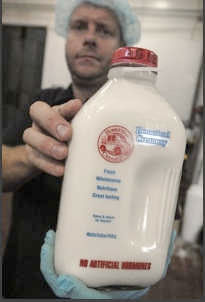 Photo from net_efekt's photostream
Photo from net_efekt's photostreamI wasn't very clear about soaking whole grain flours in an acid medium to break down phytates in the flour for making bread. Sorry. Let me see if I can explain it better.
Bread recipes call for flour, water (plus possibly other ingredients, depending on the recipe) and a leavening agent such as dry yeast or a starter. If you use a packaged yeast for the leavening, it doesn't break down the phytates (i.e. destroy the phytic acid) during the fermentation process. If you are using plain ole white flour that has been stripped of its nutrients, it probably doesn't make any difference anyway since the bran containing phytates is long gone.
If you are making a nutritional, whole grain bread, there are phytates in the milled flour, and using a starter rather than packaged yeast will help destroy the phytates. First, the starter (levain, sourdough, etc) has an active microbe population that has already destroyed most of the phytates in it. When you mix the starter with the flour and water called for in the recipe and let it sit in a cool-ish spot overnight to slowly ferment, you are letting the microbes grow and break down (digest) the phytates. This actually amounts to "soaking the flour"...
The more you slow down the fermentation time, the more phytates will be disarmed. So, if you normally mix up the ingredients, let it raise to double, punch down the dough, let it raise once more, then form and bake, you are eliminating some of the phytates. To let the dough rise longer (thus what is called a slow ferment), and punch it down at least once or twice again before forming, you need cooler temps.
My kitchen is generally cool, and I can leave mine on the counter, let it rise and punch it down 2-3 times after it has first fermented overnight, and put-off baking until perhaps 36 hours from when I first began, destroying more of the phytates.
Fermenting more than 48 hours is pretty useless because by then there are few phytates remaining and your dough could begin to spoil as the microbes have nothing to eat. One of the reason to refrigerate starters between use is to keep the living microbes dormant, not dead. Bringing the microbes out of dormancy by putting the starter back in room temperatures and feeding re-activates the starter.
Any of my whole grains to be cooked as a side dish or a cooked cereal, are soaked overnight in water with some Braggs Raw Apple Cider Vinegar. The acid in vinegar will break down the phytates, and the addition of the microbes in this particular raw vinegar will increase the vitamin (nutrient) content.





















